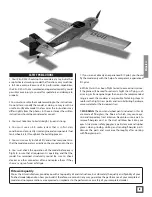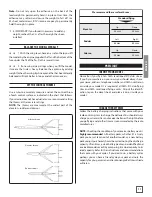
13
CHECK-LIST
During the last few moments of preparation your mind may
be elsewhere anticipating the excitement of the first flight.
Because of this, you may be more likely to overlook certain
checks and procedures that should be performed before
the model is flown. To help avoid this, a checklist is provided
to make sure these important areas are no overlooked.
Many are covered in the instruction manual, so where
appropriate, refer to the manual for complete instructions.
Be sure to check the items off as they are completed (that's
why it's called a check list!).
❍
1. Check the C.G. according to the measurements
provided in the manual.
❍
2. Be certain the battery and receiver are securely
mounted in the fuse. Simply stuffing them into place with
foam rubber is not sufficient.
❍
3. Extend your receiver antenna and make sure it has a
strain relief inside the fuselage to keep tension off the
solder joint inside the receiver.
❍
4. Balance your model laterally as explained in the
instructions.
❍
5. Use threadlocking compound to secure critical
fasteners such as the set screws that hold the wheel
axles to the struts, screws that hold the carburetor arm (if
applicable), screw-lock pushrod connectors, etc.
❍
6. Add a drop of oil to the axles so the wheels will turn
freely.
❍
7. Make sure all hinges are securely glued in place.
❍
8. Reinforce holes for wood screws with thin CA where
appropriate (servo mounting screws, cowl mounting
screws, etc.).
❍
9. Confirm that all controls operate in the correct direction
and the throws are set up according to the manual.
❍
10. Make sure there are silicone retainers on all the
clevises and that all servo arms are secured to the servos
with the screws included with your radio.
❍
11. Secure connections between servo wires and Y
connectors or servo extensions and the connection
between your battery pack and the on/off switch with
vinyl tape, heat shrink tubing or special clips suitable for
that purpose.
❍
12. Make sure any servo extension cords you may have
used do not interfere with other systems (servo arms,
pushrods, etc.).
❍
13. Balance your propeller (and spare propellers).
❍
14. Tighten the propeller nut and spinner.
❍
15. Place your name, address, AMA number and
telephone number on or inside your model.
❍
16. If you wish to photograph your model, do so before
your first flight.
❍
17. Range check your radio when you get to the flying
field.
Remember to think.
Have a ball!
But always stay in control and fly in
a safe manner.
GOOD LUCK AND
GREAT FLYING!
ENGLISH


































